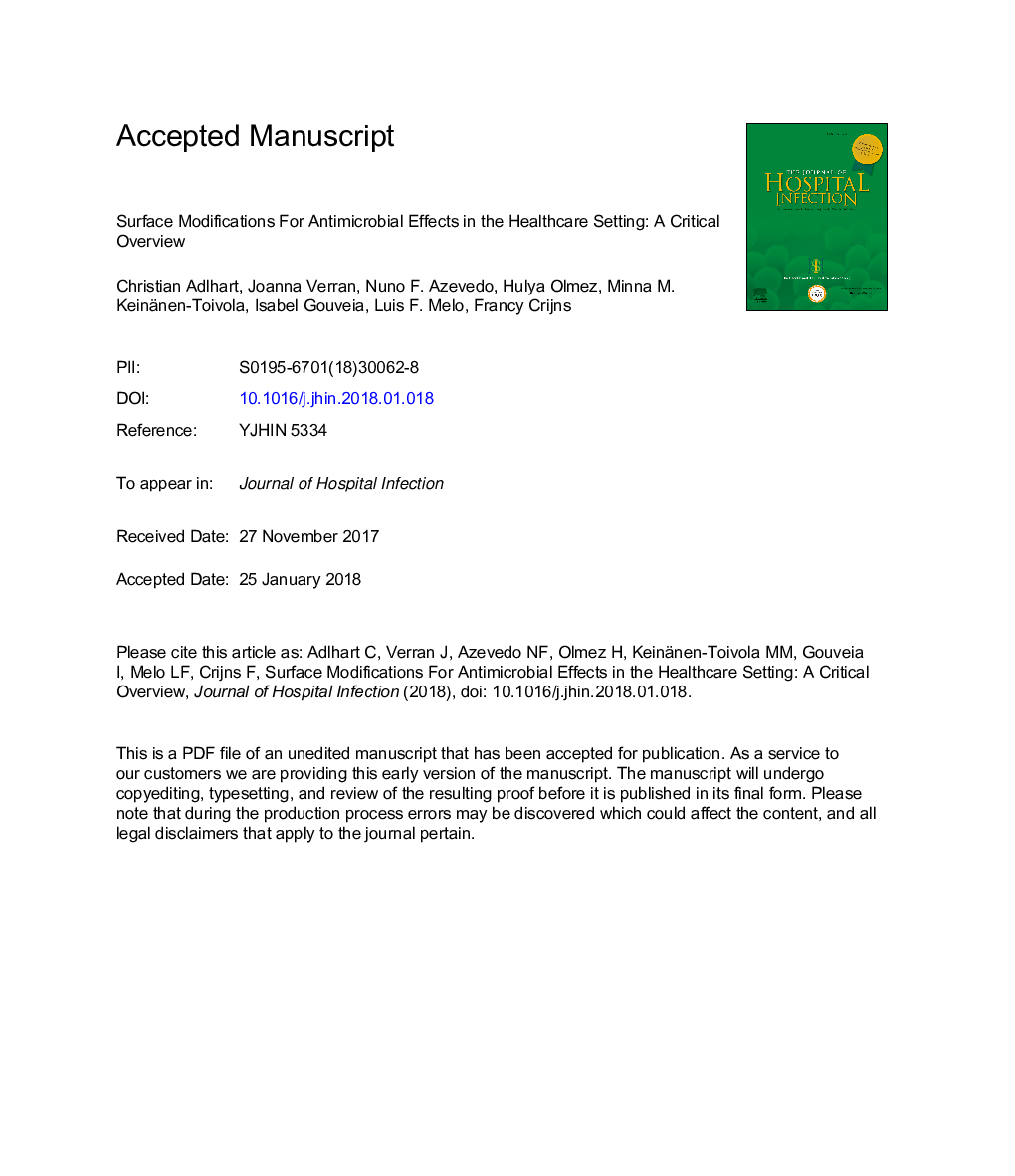| کد مقاله | کد نشریه | سال انتشار | مقاله انگلیسی | نسخه تمام متن |
|---|---|---|---|---|
| 8739946 | 1592386 | 2018 | 29 صفحه PDF | دانلود رایگان |
عنوان انگلیسی مقاله ISI
Surface modifications for antimicrobial effects in the healthcare setting: a critical overview
ترجمه فارسی عنوان
تغییرات سطحی برای اثرات ضد میکروبی در تنظیمات مراقبت های بهداشتی: یک مرور کلی مهم است
دانلود مقاله + سفارش ترجمه
دانلود مقاله ISI انگلیسی
رایگان برای ایرانیان
کلمات کلیدی
آلودگی بهداشتی، پوشش های ضد میکروبی، ایمن توسط طراحی،
ترجمه چکیده
گسترش عفونت ها در محیط های بهداشتی یک مشکل مداوم و رو به رشد در اکثر کشورها است که با توسعه مقاومت میکروبی به آنتی بیوتیک ها و ضد عفونی کننده ها تشدید می شود. علاوه بر استفاده از وسایل پزشکی (مانند ایمپلنت، کاتتر)، چنین عفونت هایی ممکن است از چسبندگی میکروب ها به داخل رابط های جامد آب خارجی مانند کلاه های دوش، شیپور خاموشی، تخلیه و غیره، یا اتصالات خارجی گاز جامد مانند دستگیره های درب، لباس، پرده، صفحه کلید کامپیوتر و غیره. اینها تمرکز اصلی کار حاضر هستند، که در آن یک مرور کلی از پوشش های ضد میکروبی برای چنین کاربردی ارائه شده است. این بررسی متشکل از روشهای شناخته شده و جدید است، از جمله اصلاح شیمیایی و عملکرد فیزیکی سطوح برای کاهش آلودگی میکروبی، و نیز خطرات احتمالی مرتبط با اجرای چنین اقدامات ضد انفجاری. به عنوان مثال سطوح ضد چسبنده (مانند سوپر هیدروفوفیک، زویتیون)، سطوح تماس تماس (مانند برس های پلیمری، فاژ ها) و سطوح آزاد سازی بیوسیستم (به عنوان مثال، انتشار آزاد شده، سیستم های مبتنی بر حساسیت قاعده)، مورد بحث قرار گرفته است. این بررسی همچنین تأثیر تغییرات توپوگرافی را در ابعاد مشخص (مقادیر میکرومتر و نانومتر) و اهمیت استفاده از معیارهای طراحی شده (از جمله سمیت، سهم برای به دست آوردن ناخواسته مقاومت ضد میکروبی، ثبات بلند مدت) در هنگام توسعه و اجرای سطوح ضد میکروبی.
موضوعات مرتبط
علوم زیستی و بیوفناوری
ایمنی شناسی و میکروب شناسی
میکروبیولوژی و بیوتکنولوژی کاربردی
چکیده انگلیسی
The spread of infections in healthcare environments is a persistent and growing problem in most countries, aggravated by the development of microbial resistance to antibiotics and disinfectants. In addition to indwelling medical devices (e.g. implants, catheters), such infections may also result from adhesion of microbes either to external solid-water interfaces such as shower caps, taps, drains, etc., or to external solid-gas interfaces such as door handles, clothes, curtains, computer keyboards, etc. The latter are the main focus of the present work, where an overview of antimicrobial coatings for such applications is presented. This review addresses well-established and novel methodologies, including chemical and physical functional modification of surfaces to reduce microbial contamination, as well as the potential risks associated with the implementation of such anticontamination measures. Different chemistry-based approaches are discussed, for instance anti-adhesive surfaces (e.g. superhydrophobic, zwitterions), contact-killing surfaces (e.g. polymer brushes, phages), and biocide-releasing surfaces (e.g. triggered release, quorum sensing-based systems). The review also assesses the impact of topographical modifications at distinct dimensions (micrometre and nanometre orders of magnitude) and the importance of applying safe-by-design criteria (e.g. toxicity, contribution for unwanted acquisition of antimicrobial resistance, long-term stability) when developing and implementing antimicrobial surfaces.
ناشر
Database: Elsevier - ScienceDirect (ساینس دایرکت)
Journal: Journal of Hospital Infection - Volume 99, Issue 3, July 2018, Pages 239-249
Journal: Journal of Hospital Infection - Volume 99, Issue 3, July 2018, Pages 239-249
نویسندگان
C. Adlhart, J. Verran, N.F. Azevedo, H. Olmez, M.M. Keinänen-Toivola, I. Gouveia, L.F. Melo, F. Crijns,
